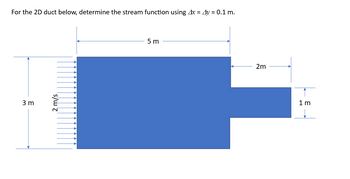
Concept explainers

To determine the stream function for the given 2D duct flow, you can use the finite difference method with the given grid spacing of The stream function
satisfies the 2D continuity equation:
In your case, the flow is steady (time-independent), so the continuity equation is simplified to:
Now, let's solve for using the finite difference method. We'll need to discretize the domain and apply the finite difference formula to approximate the Laplacian. Given the dimensions of the duct and the flow velocity, let's set up a grid. We'll use subscripts i and j to denote grid points in the x and y directions, respectively. The grid spacing is
in the x-direction, We have 5 m of length, so there are 50 grid points
In the y-direction, we have 2 m of height, so there are 20 grid points
Now, you can use the finite difference method to solve for Here are the steps:
1. Initialize at the boundary conditions.
2. Apply the finite difference formula to calculate at each interior grid point (excluding the boundaries) using the Laplacian equation:
3. Repeat the calculation until converges (changes become negligible).
4. Once you have at all grid points, you've determined the stream function for the given flow. This process will yield the stream function
for the 2D duct flow with the specified grid spacing and boundary conditions.
Step by stepSolved in 3 steps with 23 images

- Problem 11.11 Air at 60°C flows through the very wide duct. Suppose that L = 210 mm. v = 18.9(106) m²/s. (Figure 1) Figure 0.5 m/s L x = 4m 1 of 1 0.5 m/s Part A Determine the required dimension a of the duct at x = 4 m so that the central core flow velocity maintains the constant free-stream velocity of 0.5 m/s. Express your answer to three significant figures and include the appropriate units. a = Value Submit μA Provide Feedback Request Answer Units ?arrow_forwardConverging duct flow is modeled by the steady, two-dimensional velocity field V = (u, v) = (U, + bx) i – by j. For the case in which Uo = 3.56 ft/s and b= 7.66 s-1, plot several streamlines from x= 0 ft to 5 ft and y= -2 ft to 2 ft. Be sure to show the direction of the streamlines. (Please upload you response/solution using the controls provided below.)arrow_forwardSolve and explain so it is easy to understandarrow_forward

 Structural Analysis (10th Edition)Civil EngineeringISBN:9780134610672Author:Russell C. HibbelerPublisher:PEARSON
Structural Analysis (10th Edition)Civil EngineeringISBN:9780134610672Author:Russell C. HibbelerPublisher:PEARSON Principles of Foundation Engineering (MindTap Cou...Civil EngineeringISBN:9781337705028Author:Braja M. Das, Nagaratnam SivakuganPublisher:Cengage Learning
Principles of Foundation Engineering (MindTap Cou...Civil EngineeringISBN:9781337705028Author:Braja M. Das, Nagaratnam SivakuganPublisher:Cengage Learning Fundamentals of Structural AnalysisCivil EngineeringISBN:9780073398006Author:Kenneth M. Leet Emeritus, Chia-Ming Uang, Joel LanningPublisher:McGraw-Hill Education
Fundamentals of Structural AnalysisCivil EngineeringISBN:9780073398006Author:Kenneth M. Leet Emeritus, Chia-Ming Uang, Joel LanningPublisher:McGraw-Hill Education
 Traffic and Highway EngineeringCivil EngineeringISBN:9781305156241Author:Garber, Nicholas J.Publisher:Cengage Learning
Traffic and Highway EngineeringCivil EngineeringISBN:9781305156241Author:Garber, Nicholas J.Publisher:Cengage Learning





